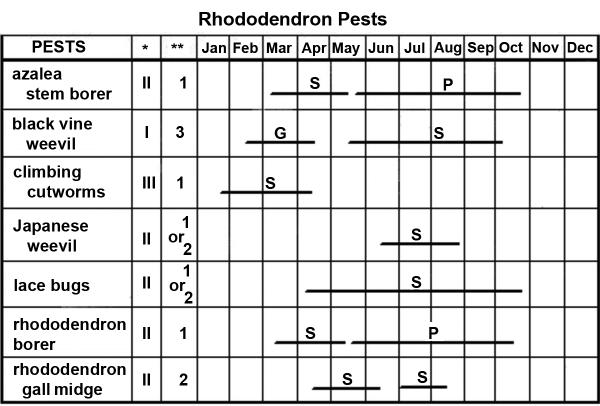Caution
This information was developed for North Carolina and may not apply to other areas.
Please click on the thumbnail to enlarge it or jump to the last section to view an accessible version of the table in HTML format.
Table Legend
* Degree of importance of pest: I = Important pest, high probability of occurrence; II = Treat as needed; III = Occasional pest, treat when detected.
** Number of applications needed for most effective control. It is usually best to wait 10 to 14 days between applications in cool weather and 7 to 10 days between applications in warm weather.
G = granular; P = prune out infested twigs or branches; S = spray application.
Rhododendron Pest Management Calendar
| Pests | Degree of Importance of Pest* | Number of applications** | Jan | Feb | Mar | Apr | May | Jun | Jul | Aug | Sep | Oct | Nov | Dec |
|---|---|---|---|---|---|---|---|---|---|---|---|---|---|---|
| azalea stem borer | II | 1 |
Spray Application |
Spray Application |
Spray Application/ prune out infested twigs or branches |
prune out infested twigs or branches | prune out infested twigs or branches | prune out infested twigs or branches | prune out infested twigs or branches | prune out infested twigs or branches | ||||
| black vine weevil | I | 3 | granular | granular | granular |
Spray Application |
Spray Application |
Spray Application |
Spray Application |
Spray Application |
||||
| climbing cutworms | III | 1 |
Spray Application |
Spray Application |
||||||||||
| Japanese weevil | II | 1 or 2 |
Spray Application |
Spray Application |
Spray Application |
|||||||||
| lace bugs | II | 1 or 2 |
Spray Application |
Spray Application |
Spray Application |
Spray Application |
Spray Application |
Spray Application |
Spray Application |
|||||
| rhododendron borer | II | 1 |
Spray Application |
Spray Application |
Spray Application/ prune out infested twigs or branches |
prune out infested twigs or branches | prune out infested twigs or branches | prune out infested twigs or branches | prune out infested twigs or branches | prune out infested twigs or branches | ||||
| rhododendron gall midge | II | 2 |
Spray Application |
Spray Application |
|
Spray Application |
Spray Application |
* Degree of importance of pest: I=Important pest, high probability of occurrence, II=Treat as needed: III=Occasional pest, treat when detected.
** Number of applications needed for most effective control. It is usually best to wait 10 to 14 days between applications in cool weather and 7 to 10 days between applications in warm weather.
Other Resources
- Azalea Stem Borer. Frank, S. and J. R. Baker. 2020 (revised). Entomology Insect Notes, NC State Extension Publications.
- Black Vine Weevil. Frank, S. et al. 2020 (revised). Entomology Insect Notes, NC State Extension Publications.
- Caterpillars That Feed on Trees and Shrubs. Frank, S. and S. Bambara. 2009. Entomology Insect Notes, NC State Extension Publications.
- Rhododendron Borer. Baker, J. R. 2021 (revised). PDIC Factsheets, NC State Extension Publications.
- Rhododendron Gall Midge. Baker, J. R. 2019 (revised). PDIC Factsheets, NC State Extension Publications.
- Lace Bugs. Frank, S. 2019 (revised). Entomology Insect Notes, NC State Extension Publications.
- Twobanded Japanese Weevil. Frank, S. and J. R. Baker. 2019 (revised). Entomology Insect Notes, NC State Extension Publications.
- Insect and Related Pests of Shrubs. Baker, J. R. ed. 1980. NC Agricultural Extension Service publication AG-189. 199 pp.
- North Carolina Agricultural Chemicals Manual
- Extension Plant Pathology Publications and Factsheets
- Horticultural Science Publications
- Search for more information on insects from NC State Extension
For assistance with a specific problem, contact your local N.C. Cooperative Extension Center.
This Insect Note has not been peer reviewed.
Publication date: Feb. 4, 2019
Reviewed/Revised: Nov. 10, 2023
N.C. Cooperative Extension prohibits discrimination and harassment regardless of age, color, disability, family and marital status, gender identity, national origin, political beliefs, race, religion, sex (including pregnancy), sexual orientation and veteran status.

